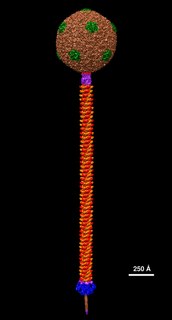
A bacteriophage, also known informally as a phage, is a duplodnaviria virus that infects and replicates within bacteria and archaea. The term was derived from "bacteria" and the Greek φαγεῖν, meaning "to devour". Bacteriophages are composed of proteins that encapsulate a DNA or RNA genome, and may have structures that are either simple or elaborate. Their genomes may encode as few as four genes and as many as hundreds of genes. Phages replicate within the bacterium following the injection of their genome into its cytoplasm.
Command & Conquer (C&C) is a real-time strategy (RTS) video game franchise, first developed by Westwood Studios. The first game was one of the earliest of the RTS genre, itself based on Westwood Studios' influential strategy game Dune II and introducing trademarks followed in the rest of the series. This includes full-motion video cutscenes with an ensemble cast to progress the story, as opposed to digitally in-game rendered cutscenes. Westwood Studios was taken over by Electronic Arts in 1998 and closed down in 2003. The studio and some of its members were absorbed into EA Los Angeles, which continued development on the series.

A foxhound is a type of large hunting hound bred for strong hunting instincts, a keen sense of smell, and their bark, energy, drive, and speed. In fox hunting, the foxhound's namesake, packs of foxhounds track quarry, followed—usually on horseback—by the hunters, sometimes for several miles at a stretch; moreover, foxhounds also sometimes guard sheep and houses.

Mycobacterium is a genus of Actinomycetota, given its own family, the Mycobacteriaceae. Over 190 species are recognized in this genus. This genus includes pathogens known to cause serious diseases in mammals, including tuberculosis and leprosy in humans. The Greek prefix myco- means 'fungus', alluding to the way mycobacteria have been observed to grow in a mold-like fashion on the surface of cultures. It is acid-fast and cannot be stained by the Gram stain procedure.

The Pokémon Trading Card Game, abbreviated as PTCG or Pokémon TCG, is a collectible card game based on the Pokémon franchise. It was first published in October 1996 by Media Factory in Japan. In the US, it was first published by Wizards of the Coast. In June 2003, Nintendo transferred the publishing rights from both Media Factory and Wizards of the Coast to The Pokémon Company. As of March 2022, the game has sold over 43.2 billion cards worldwide.

Phage therapy, viral phage therapy, or phagotherapy is the therapeutic use of bacteriophages for the treatment of pathogenic bacterial infections. This therapeutic approach emerged at the beginning of the 20th century but was progressively replaced by the use of antibiotics in most parts of the world after the second world war. Bacteriophages, known as phages, are a form of virus that attach to bacterial cells and inject their genome into the cell. The bacteria's production of the viral genome interferes with its ability to function, halting the bacterial infection. The bacterial cell causing the infection is unable to reproduce, and instead produces additional phages. Phages are very selective in the strains of bacteria they are effective against.

A jet pack, rocket belt, or rocket pack is a device worn on the back which uses jets of gas or liquid to propel the wearer through the air. The concept has been present in science fiction for almost a century and became widespread in the 1960s. Real jet packs have been developed using a variety of mechanisms, but their uses are much more limited than their fictional counterparts because of the challenges of the Earth's atmosphere, gravity, the low energy density of utilisable fuels, and the human body not being suited to flight, and they are principally used for stunts. A practical use for the jet pack has been in extra-vehicular activities for astronauts because of the apparent weightlessness and lack of friction-creating atmosphere in orbit. The term jet suit is used for a system incorporating a jet pack and associated jets attached to the arms to increase manoeuvrability.

Mycobacterium bovis is a slow-growing aerobic bacterium and the causative agent of tuberculosis in cattle. It is related to Mycobacterium tuberculosis, the bacterium which causes tuberculosis in humans. M. bovis can jump the species barrier and cause tuberculosis-like infection in humans and other mammals.

The Hartford Wolf Pack are a professional ice hockey team based in Hartford, Connecticut. A member of the American Hockey League (AHL), they play their home games at the XL Center. The team was established in 1926 as the Providence Reds. After a series of relocations, the team moved to Hartford in 1997 as the Hartford Wolf Pack. It is one of the oldest professional hockey franchises in existence, and the oldest continuously operating minor league hockey franchise in North America.

Robert John Pack Jr. is an American professional basketball coach and former player. He last coached the Rwandan club REG of the Basketball Africa League A 6 ft 2 in (1.88 m) point guard, he played 13 seasons in the National Basketball Association (NBA).

Marvel: Ultimate Alliance is a 2006 action role-playing video game, developed by Raven Software for the PlayStation 2, PlayStation 3, Xbox and Xbox 360, and published by Activision. The game was ported to the PlayStation Portable and Wii by Vicarious Visions, and to Microsoft Windows by Beenox. A different Game Boy Advance version was developed by Barking Lizards Technologies. A re-release version based on Xbox 360's latest edition was developed by Zoë Mode for Windows, PlayStation 4, and Xbox One, and was released in July 2016.

A mycobacteriophage is a member of a group of bacteriophages known to have mycobacteria as host bacterial species. While originally isolated from the bacterial species Mycobacterium smegmatis and Mycobacterium tuberculosis, the causative agent of tuberculosis, more than 4,200 mycobacteriophage have since been isolated from various environmental and clinical sources. 2,042 have been completely sequenced. Mycobacteriophages have served as examples of viral lysogeny and of the divergent morphology and genetic arrangement characteristic of many phage types.
Empire Earth is a series of real-time strategy video games developed by Stainless Steel Studios and Mad Doc Software, and published by Sierra Entertainment. The games in the series are historical RTS games that are similar to Age of Empires. Rick Goodman, who designed Empire Earth and Empires: Dawn of the Modern World, was one of the lead designers of Age of Empires. The games use the Titan and Titan 2.0 engine, which was sold after Stainless Steel Studios closed.

Mycobacteroides abscessus is a species of rapidly growing, multidrug-resistant, nontuberculous mycobacteria that is a common soil and water contaminant. Although M. abscessus most commonly causes chronic lung infection and skin and soft tissue infection (SSTI), it can also cause infection in almost all human organs, mostly in patients with suppressed immune systems. Amongst NTM species responsible for disease, infection caused by M. abscessus complex are more difficult to treat due to antimicrobial drug resistance.

Steffanie A. Strathdee is the Associate Dean of Global Health Sciences, Harold Simon Professor at the University of California San Diego School of Medicine and Co-Director at the Center for Innovative Phage Applications and Therapeutics. She has been awarded more than US$64 million in federal research grants as a principal investigator. She is known for her work on HIV research and prevention programmes in Tijuana.
Giles is a bacteriophage that infects Mycobacterium smegmatis bacteria. The genome of this phage is very different from that of other mycobacteriophages and is highly mosaic. More than half of its predicted genes are novel and are not seen in other species.
Fromanvirus is a genus of viruses in the order Caudovirales, in the family Siphoviridae. Bacteria serve as natural hosts, with transmission achieved through passive diffusion. There are 59 species in this genus.
Mycobacterium virus Jeffabunny is a bacteriophage known to infect bacterial species of the genus Mycobacterium.
Mycobacterium virus D29 (D29) is a Cluster A mycobacteriophage belonging to the Siphoviridae family of viruses, it was discovered in 1954 by S. Froman. D29 is notable for its ability to infect M. tuberculosis. D29 is a double stranded DNA mycobacteriophage. It is a lytic phage, this means that D29 takes the lytic pathway of infection instead of the lysogenic pathway of infection. There are no human associated diseases associated with mycobacterium virus D29.

Microbacterium virus MuffinTheCat is a species of bacteriophage in the family Tectiviridae. It was collected and identified by Darcy Reimer on 1 October 2019. It is part of the Microbacterium testaceum NRRL B-24232 viral strand and the GE viral cluster. Microbacterium of the Microbacterium testaceum species serve as natural hosts. Microbacterium virus MuffinTheCat is morphologically almost indistinguishable from its sibling species in the Tectiviridae family, but it along with its sibling species in the GE cluster are different enough from other Tectiviridae members that the GE cluster may soon be identified as a new genus. Microbacterium virus MuffinTheCat is identified from other GE cluster members by its genome differences.













